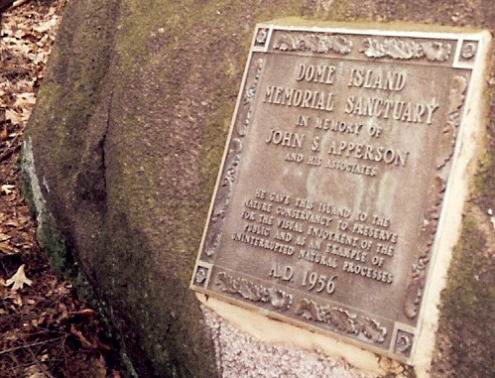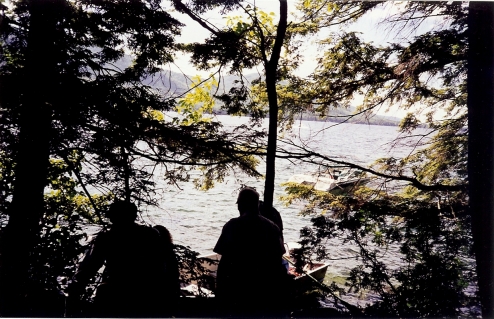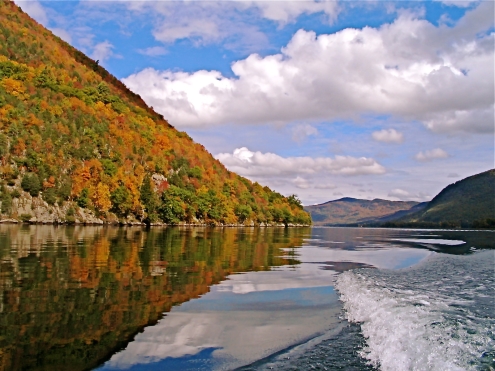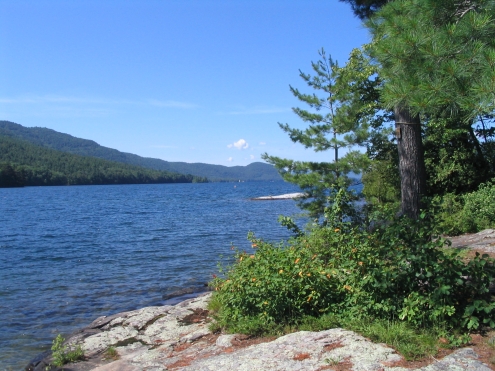
This past fall the Lake George Association (LGA) partnered with the Warren County Soil and Water Conservation District (WCSWCD), the Towns of Bolton and Queensbury Highway Departments and the Warren County DPW on several very important stormwater retrofit projects that will provide great protection for Lake George for many years to come. Fourteen new dry wells were installed, twelve in the Town of Bolton and two in the Town of Queensbury, with plans for more to be installed in Queensbury next spring.
“Even though there has been a lot of talk about invasive species and Lake George lately, we have not forgotten that stormwater runoff is still the number one source of pollutants to the Lake,” said LGA’s Outreach Coordinator Emily DeBolt. “So in addition to our invasive species work this past summer, with our award winning Lake Steward Program and other activities, staff at the LGA was also hard at work protecting the lake from stormwater runoff.”
After a storm, water that falls on soil can infiltrate down into the ground and eventually into the groundwater. Water that falls on impervious surfaces, such as roads and parking lots, cannot soak into the ground, and instead moves across these surfaces, picking up speed and pollutants- becoming stormwater runoff. Oils, salt, and sediment carrying phosphorous or other chemicals are also picked up by the water as it travels and are all eventually deposited into the Lake.
“Roadside drainage improvements such as catch basins, dry wells, and roadside ditch improvements, are all projects that the LGA undertakes with partners that protect the lake from nonpoint source pollution carried by stormwater runoff,” said LGA’s Executive Director Walt Lender. “We were very pleased to be able to get these projects in the ground before this winter. That way they are in place to protect the Lake from large amounts of runoff created by snowmelt in the spring.”
In the Town of Queensbury, Sunset Lane on Assembly Point was scheduled to be repaved this fall by the Town. Prior to paving, a stormwater issue was brought to the attention of both the Town and the WCSWCD by local residents. Staff from WCSWCD came up with a retrofit design and approached the LGA to see if it was interested in helping out with the project. With funding available from the Helen V. Froehlich Foundation for this type of work, the LGA jumped at the opportunity to be able to help address this stormwater issue. “This project was a great example of good timing and communication”, said Randy Rath, the LGA’s project manager. “Because the drainage issue came to light before the road was re-paved, we were able to address it. Had the Town gone ahead and just done the paving work, it might not have worked out. ”
The project involved installing two 8 foot diameter dry wells that will capture runoff from a small 3,200 square foot watershed on the southeast side of the lake and allow it to infiltrate into the ground rather than run directly to the lake. The Town of Queensbury Highway department completed all of the installation work with WCSWCD overseeing the entire project this past September. The LGA provided $2,395.00 in funding for the two dry wells. The Town of Queensbury supplied the stone. Additionally, while onsite viewing the installation of the last dry well, another stormwater retrofit project was identified and discussed with the Town and Soil and Water that could be implemented as early as next spring utilizing the same strategy.
After the successful installations in Queensbury, work moved up the Lake to the Town of Bolton where nine 4 foot by 8 foot dry wells were installed in three different areas. The first location was at the old Town of Bolton highway garage and transfer station, where there is over 11,000 square feet of impervious surface that had been generating untreated runoff into Finkle Brook during storm events. The WCSWCD worked with the town’s highway department and Kingsley Excavating to install a single dry well at the back of the property and a side by side installation of two additional dry wells in the corner of the transfer station. The three dry wells and a re-established rock lined swale now handle all of the runoff from the site and treat it before it reaches Finkle Brook.
On Mohican Avenue two 4 foot by 8 foot dry wells were added along the south side of the steep town owned road that has a track record of eroding during storm events. Each dry well is in a separate location and both have a paved swale leading to them. Overflow from the dry wells runs into the woods behind the structures where the stormwater can slowly infiltrate into the soil. Kingsley Excavating completed the work with technical design and project oversight coming from WCSWCD.
Horicon Avenue, also a steep road, is owned by Warren County and the work at this site was completed with in-kind services from the County DPW department. With the planning assistance of the WCSWCD, three dry well systems were initially installed. A single dry well was added on the East side of Horicon near Highland Drive. On the West side of Horicon, two side by side dry wells were installed to capture runoff from a 1700 foot length of road. Additionally along the West side of the road a fourth 4 foot by 8 foot dry well structure was added before the project was complete. This structure was located 500 feet below the previous structure. In all of the locations, the gutter of the road was reconstructed to direct the stormwater into the structures to reduce any erosion potential.
“The LGA contributed $2,969 for materials and $4,000 for labor to the Bolton projects that wrapped up in early October. As the Warren County DPW completed their work with WCSWCD on Horicon Avenue, they realized that they liked how the other structures were working and thought they could add three additional dry wells on Horicon, but had not budgeted for the materials,” said LGA’s Project Manager Randy Rath. “The County DPW asked the LGA if we could help out and purchase the three dry well systems. Utilizing funding designated for Stormwater Retrofits in Bolton from the Helen V. Froehlich Foundation, the LGA purchased the structures for $2,480. The dry wells have a smaller footprint (4 foot diameter rather than the larger 8 foot diameter used in the other locations), but are still able to capture and treat runoff. These were placed along Horicon Avenue in early October as well. “
“We are very pleased with the outcome of these installations this past fall,” said Rath. ”We have already had some rain events and have been able to see how well they are working. Next spring we will pick up where we left off and continue our partnership with Warren County Soil and Water and the local municipalities around the Lake to stop stormwater before it has a chance to enter the Lake. We’ll start in the Town of Queensbury and place two more dry wells at the base of Sunset Lane that will capture some additional stormwater just before it enters the Lake.”








